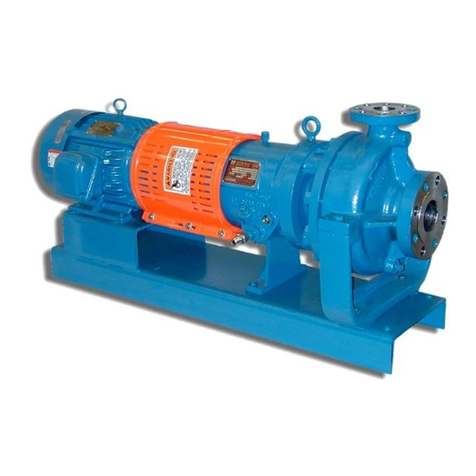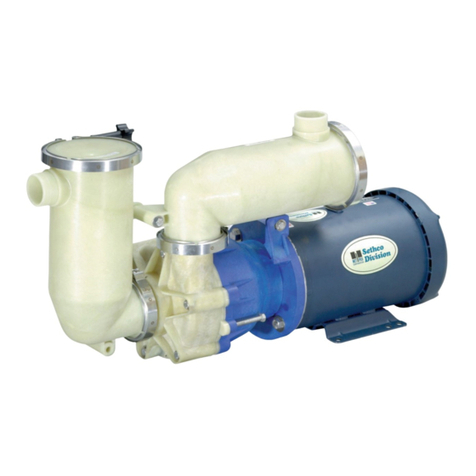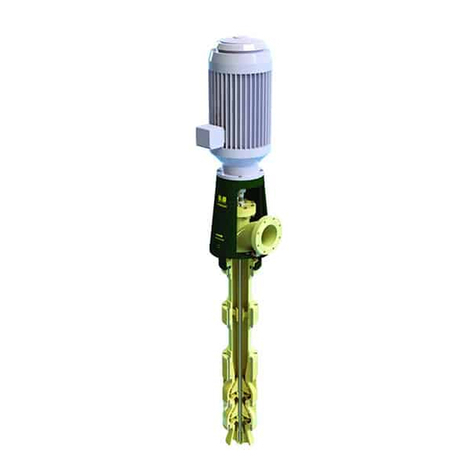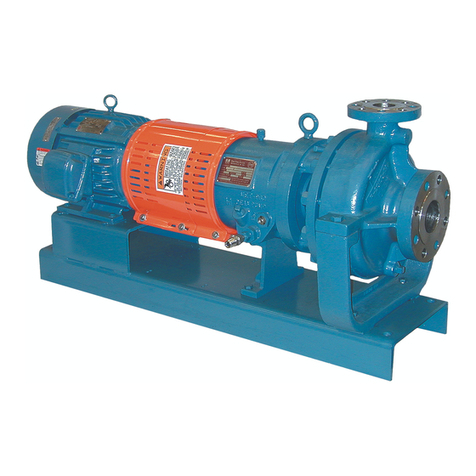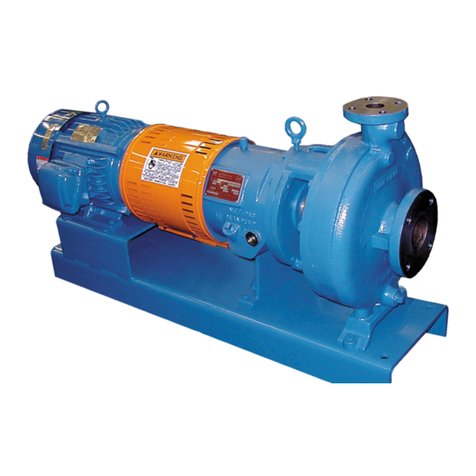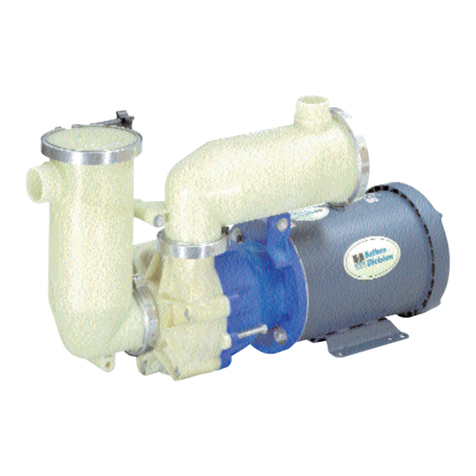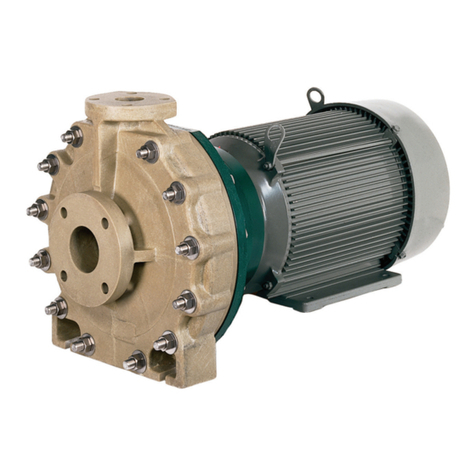
8
It is important that a pump should n v r b subj ct d to th rmal or
pr ssur shock. Th liquid should th r for b allow d to flow into
th casing slowly. A c ntrifugal pump should n v r b start d until
all th parts ar up to th t mp ratur of th liquid to b pump d.
FILLING
WARNING:
Before filling the pump with liquid, check to see that all possible
leak locations are sealed. See that all of the connections into the
pressure containing cavity are sealed or connected to a related
piping system that also has all possible leak paths sealed. Do not
plug unused cavities, as this could develop dangerous pressure
build-up. Use a wrench on all bolted oints to apply torque to assure
that all gaskets are sealed in a tight oint. Check to see that all
threaded pipe connections are also tight enough to seal the Liquid
pressure that will be applied when the system is started.
WARNING:
Filling directions below refer to venting of “air” to the atmosphere,
but dependent upon the physical properties of the liquid intended
to be pumped, temperature, pressure, and other variables related
to the system and its operational requirements, this may not be
allowed by federal or local regulations, or may not be acceptable
for whatever other reasons. Consult your plant or corporate safety
engineer for instruction on possible required procedures for the
specific liquid, operating conditions and legal requirements.
Wh n th sourc of th liquid to b pump d is b low atmosph ric
pr ssur or locat d b low th pump, th filling may b ac -
complish d in any of s v ral ways, thr of which ar list d b low:
1) An xhaust r may b conn ct d to th discharg piping
b tw n th pump and th discharg isolation valv . With th
discharg isolation valv clos d and th suction valv op n,
th air can b xhaust d from th pump and th suction pip-
ing. Wh n all th air has b n r mov d, clos th suction
valv , r mov th xhaust r, plug th acc ss port wh r th
xhaust r was conn ct d, and th n op n th discharg valv .
R mov th s al v nt plug from th top of th b aring housing,
r f r to th drawings on pag 6. Allow th air to flow from this
port until th pumpag starts to flow. This could tak consid r-
abl tim d p nd nt upon th viscosity of th pumpag .
Fift n to tw nty minut s is not unusual, how v r som liquids
may v nt out in l ss than a minut . If th pump is a “RA2096”
us a funn l and fill th s al cavity, through this conn ction
with cl an pumpag .
2) With a foot valv install d in th suction piping, th pump may
b fill d with pumpag introduc d som wh r abov th
pump in th discharg piping. A foot valv may cr at xt n-
siv loss s and th r for must b allow d for in calculating th
availabl NPSH. Wh n th pump is fill d, plug th port
through which you w r filling. R mov th s al v nt plug from
th top of th b aring housing, r f r to th drawings on pag
6. Allow th air to flow from this port until th pumpag starts
to flow. This could tak consid rabl tim d p nd nt upon th
viscosity of th pumpag . Fift n to tw nty minut s is not
unusual, how v r som liquids may v nt out in l ss than a
minut . If th pump is a “RA2096”, us a funn l and fill th
s al cavity, through this conn ction with cl an pumpag .
3) A vacuum pump (pr f rably a w t vacuum pump) may b
us d for vacuating air from th pump and piping. Th vacu-
um pump should b conn ct d as is th xhaust r cov r d in
No. 1 abov and th proc dur is th sam .
Wh n th sourc of th liquid to b pump d is abov atmosph ric
pr ssur or abov th pumps discharg flang , th pump may b
fill d by v nting through a bl d-off lin to atmosph r . Wh n th
sourc of th liquid is abov th pumps discharg flang th v nt-
ing could b back to th suction sourc , inst ad of to atmosph r .
Wh n all of th air has b n xp ll d through th bl d-off, s al it.
R mov th s al v nt plug from th top of th b aring housing, r f r
to th drawings on pag 6. Allow th air to flow from this conn c-
tion until th pumpag starts to flow. This could tak a consid rabl
amount of tim , d p nd nt upon th viscosity of th pumpag .
Fift n to tw nty minut s is not unusual, how v r som liquids may
v nt out in l ss than a minut . If th pump is a “RA2096”, us a fun-
n l to fill s al cavity, through this conn ction with cl an pumpag .
It is most important to check the direction of rotation of the pump
before allowing the pump to come up to speed. Th pump was
shipp d with th coupling spac r not install d to allow alignm nt
and motor rotation dir ction ch ck. If, how v r, som on install d
this spac r ass mbly, r mov it at this tim . To ch ck rotation dir c-
tion, push th starting button and instantly push th stop button. This
will allow th motor to turn ov r a f w r volutions and th dir ction
of rotation to b obs rv d. A dir ction of rotation arrow is shown
on th front of th pump casing. If rotation is incorr ct, chang th
wiring conn ctions and r ch ck rotation. Operating the pump in
reverse rotation may cause extensive damage.
WARNING:
Lock-out the power to the driver (motor, turbine, engine, etc.) install
the shaft coupling spacer. Be sure that you install all the retaining
devices and bolts and that they are tight. Read and comply with the
coupling manufacturer’s instructions. Personal in ury, death, and/or
equipment damage could occur if the coupling spacer is not prop-
erly installed. Remove all debris and tools from the area near the
shafts and the shaft coupling. Do this to assure that nothing is
caught and thrown by the rotating parts when the pump is started.
Bolt the coupling guard securely to the baseplate, checking to
assure that it is not contacting any parts that will rotate when the
pump is started.
OPERATING
WARNING:
Before starting the unit, see that all personnel are a safe distance
away from all possible hazards, that all sub-systems are connected
and operating, that all debris has been removed, that the shaft cou-
pling guard is securely in place, and that the pump is full of
liquid.
Do not operate this pump at shut-off (no flow) as an explosion may
result. This can occur with any liquid, even “cold water”. Personal
in ury, death, equipment damage, and/or loss of product
(pumpage) is Likely to occur. If your system is operated where it is
possible for all outlets of the discharge from the pump to be closed
while the pump is still operating, a modification of the system needs
to be made to assure a continual flow of pumpage through the
pump. NOTE: Some people have a belief that a bypass line from the
discharge side of the pump to the suction side of the pump will
relieve this problem, this is “NOT TRUE”; DO NOT ATTEMPT THIS.
WARNING:
Do not operate a pump at a low flow condition, unless provision has
been made to prevent dangerous heat build up within the pump
casing. The liquid in the pump will heat up and this may result in
high pressure in the pump in a short time. Such pressure may result
in a rupture of the pressure-containing parts and cause severe haz-
ard to personnel and/or damage to the system.
STARTING THE PUMP
